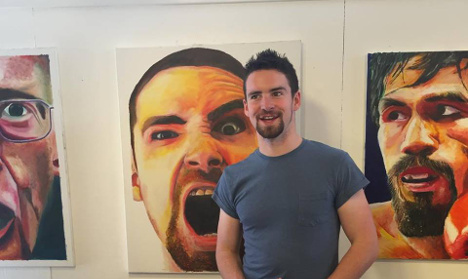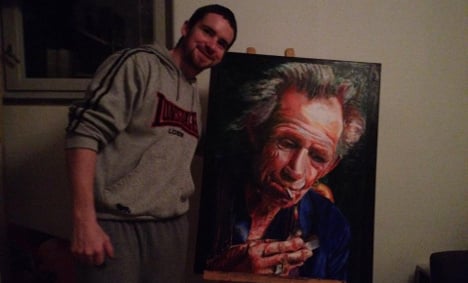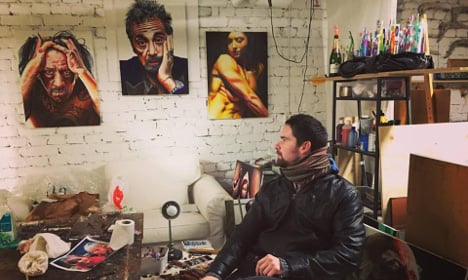“My style is big and bold,” Slevin says, referring to the colourful portraits which cover the walls of his studio. “I like the idea of people coming into the room, even young children, seeing the paintings and wanting to engage with them.”
When The Local spoke to the artist, he was preparing for his first public exhibition in Stockholm on March 6th, which he described as his “arrival in the Swedish art scene”.
However, integrating into a new country was not easy and Slevin, who has now lived in Stockholm for three years, remembers finding things difficult when he first arrived. “It took a while to settle in; even now I’m still working on the language. Swedes are polite and hospitable, but slow to invite you to their own home and treat you as a close friend – they're not quite as warm as in Ireland.”
He was able to find a part-time job as a chef, but his art had to take a back seat while he adapted to Swedish life. “I was working long hours because I was new to the country and had to grind, and I was also struggling with the language. It was very frustrating and I felt that I couldn’t express myself. I didn't have time to even get near a paintbrush.”
But it was his art which helped him cope with the difficulties of living abroad. Slevin remembers: “When I finally found the time to paint, I did a self-portrait which was very therapeutic. I felt like I was throwing all of those feelings onto the canvas, using strong reddy-orangey colours. It was great.”

Slevin with his self-portrait.
And despite the initial struggles, Slevin believes that it is easier to make a living from art in Sweden than in his hometown of Belfast. “I had more connections in Belfast as a local artist, but times are tougher back home. In Stockholm, people have more disposable income, so it is easier to sell art at higher prices.”
The Irishman's art now has a home in his Roslagsgatan studio, and he says: “I feel like I’m a part of things now. I just hope people take notice.”
He feels that he fits into the Swedish art scene well, because there is less focus on qualifications or connections and the industry is more open. “I don’t necessarily play by the rules, but I feel like that is accepted in Stockholm,” says Slevin.
Having finished school, he studied a one-year art course and then set off to travel around Australia and New Zealand. His travels ended up lasting for five years, but left the expat without much opportunity to pursue his artistic talent. But despite not having any traditional training in art, he says that he has “talent – and the confidence to use it. I’ve always loved art”.
And now that he has been here a while, he has learned to love Sweden too. In particular, Slevin explains that he is impressed by the effort the government puts into promoting art and making it accessible, for example by having 'culture weeks' where many galleries are free, and large art fairs.
“I love the idea of art being shared; everyone should be able to enjoy it and Sweden is very good at that, which is one of the reasons I’m happy here,” he says.
Slevin also feels that living in Stockholm – as well as his time spent travelling in Australia – has had an influence on his own style. “All life experiences effect you and influence your style as an artist,” he tells The Local. “My first exhibition was called Faces We’ve Earned, and that reflects an idea I’m very interested in, that the life someone leads affects the way you look and think, and you can see it in their face.”

With one of his portraits of rock legend Keith Richards.
When it comes to choosing subjects, the artist likes to depict people who have had a strong influence on him, whether that is a celebrity – his most recent subject was American writer Ursula K. Le Guin, after reading one of her novels – or simply a passer-by. For example, he remembers taking a photo of someone in a Viking outfit outside a Stockholm pub and later turning it into a painting.
But what about famous Swedes – is there anyone he'd like to paint? “Maybe a Skarsgård,” Slevin says, referring to the Swedish acting family. “Maybe the royal family, but for me they are too pretty, especially the younger ones – I like to paint old, grey characters with wrinkles and sharp features.”
As for what he has planned next, all he will say is that he’d “like to do something completely different, something large and abstract.”



 Please whitelist us to continue reading.
Please whitelist us to continue reading.
Member comments